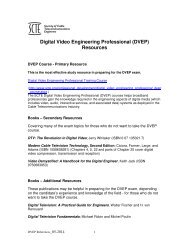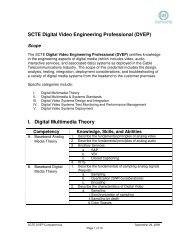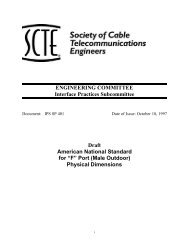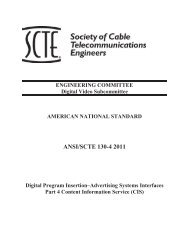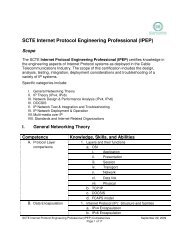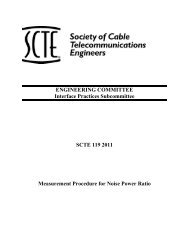SCTE IPS Template, Rev 2
SCTE IPS Template, Rev 2
SCTE IPS Template, Rev 2
- No tags were found...
You also want an ePaper? Increase the reach of your titles
YUMPU automatically turns print PDFs into web optimized ePapers that Google loves.
It is important to note that the test, as previously outlined in the procedure, is designed toindicate a certain level of distortion generated from within the system (or device), which can bemeasured in a repeatable manner. It is not, however, designed to be representative of actualperformance even though the carrier levels may be the same, because the actual video signaldoes not contain modulation at a 100% level. As well there are other factors, such as theVertical Sync Pulse and the actual video level contained within the picture information, that canaffect the magnitude of the measured AM-XMOD within a given measurement bandwidth. Themethodology of the test therefore minimizes the subjective performance that can be incurred bythese factors and provides the basis for correlation to actual system performance.Since the primary stimulus signal also serves as the reference for the (relative) measurement ofAM-XMOD distortion, this signal should first be examined. Since, as well, the stimulus signalcan be examined in both the ‘time’ domain and ‘frequency’ domain, it is important to view thesignal in both domains graphically. Figure 1 shows the time response of a carrier signal withoutmodulation. Figure 2 shows the same signal in the frequency domain, where the magnitude ofthe Power Spectral Density is plotted versus frequency. Both of these signals can be representedby the following (time domain) expression:y 1 (t) = V pk cos (w c t + θ)Where:θ = 0, can be chosen for simplification.This expression will serve as our reference, in order to simplify future discussions.{B.1}Figure 3 shows the signal when modulated with a low frequency square-wave that has a 50%duty cycle. As shown, the carrier is pulsed ON and OFF for equal periods of time, creating asymmetric, pulsed RF signal. Note that this represents 100% downward amplitude modulationof the carrier.Since the depth of the (downward) modulation, from the peak of the envelope of the carrier,represents the analog level of the video, we can see that no video information is embodied bythis test signal. In other words, the test signal carries no video energy and the envelope of themodulation corresponds to the energy of the Horizontal Sync pulse only, as desired.The test signal, as shown, can be characterized by the following expression:y 2 (t) = V pk u a(t) cos (w c t + θ)Where:u ≡ the index of modulation, chosen to be 100% (i.e. amagnitude of 1.0).{B.2}a(t) ≡ the modulating signal; a square-wave, with a dutycycle of 50% and frequency of 15.75 kHz.An expression can be given for the term a(t), using a Fourier series:a(t) = {1/2 + (2/π) [Σ k (1/k) sin(k w mod t + φ)]}; k = 1, 3, 5…∞{B.3}Where: w mod = 15.75 kHz, the rate of modulation.φ = 0, chosen for convenience.Note that, given the modulation is “downward only”, the peak magnitude of the carrier due toa(t) is “V pk ” when measured in the time domain, as it is when the carrier contains no modulation.24






